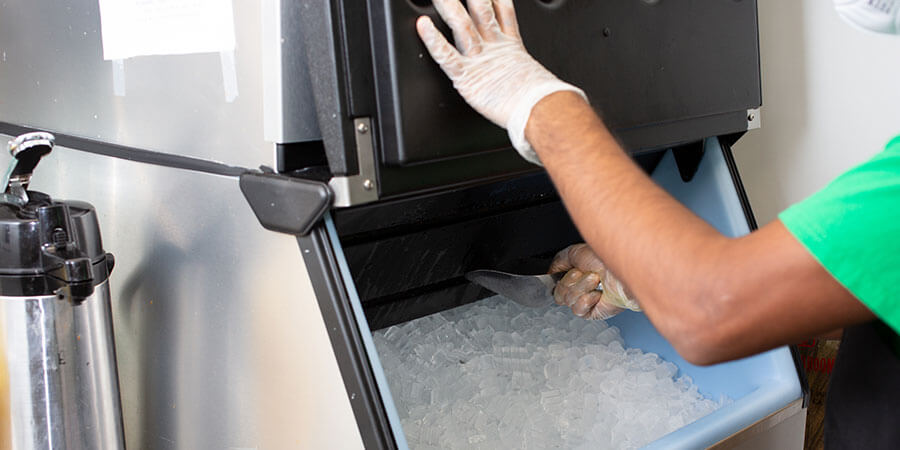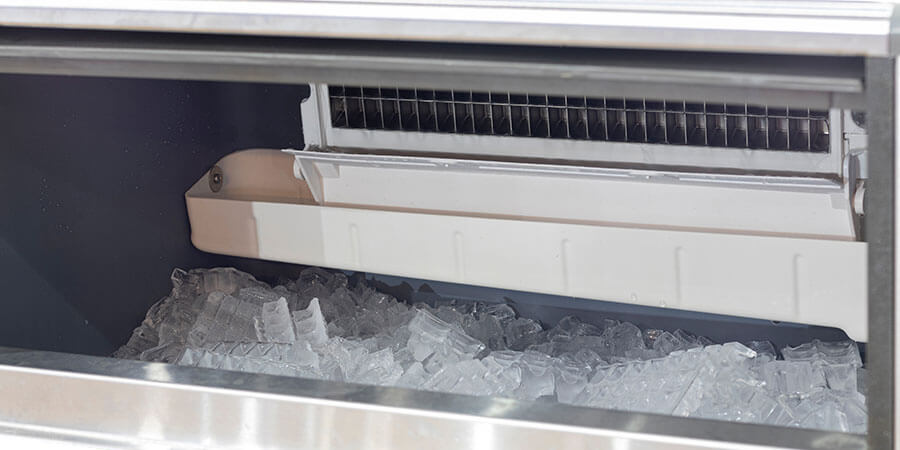How to Clean an Ice Machine by Hoshizaki in 4 Steps

Most commercial ice machines, including those made by Hoshizaki, need to be deep-cleaned at least once a year, if not more frequently to remain sanitary and operate efficiently. So it’s important to know how to clean your Hoshizaki ice maker.
While you can certainly read the resource we’ve just linked to or refer to your specific ice maker’s owner’s manual, we’ve compiled the following easy-to-read guide so you can gain an understanding of how to clean your ice machine in less time! With that in mind, let’s dive into the 4 steps you can take to get your ice machine from dirty to clean!
1. Pre-Cleaning Steps
Cleaning a Hoshizaki ice machine involves three main components: descaling, disinfecting, and sanitizing. But before you can start on any of those, you’ll need to do the following, per this Easy Ice guide:
- Turn your ice machine off.
- Locate the water shut-off valve located near the machine and turn that off. If there isn’t one, you’ll have to cut the water supply to the ice machine off another way.
- Remove any panels you need so that you can access the interior of the ice machine. For instance, the ice machine in this video has a front panel that requires removal. Your ice machine may differ slightly from that one.
- Empty the reservoir. To see how to do this for your specific ice machine model, refer to the owner’s manual.
- Remove the old water filter and put in a new one (if you have one on your ice machine) per the instructions found in your owner’s manual.
Once you’ve completed the above steps, it’s time to descale, disinfect, and sanitize your ice machine.
Note: You must complete these processes in multiple different parts of the ice machine, including the ice bin interior, the evaporator, the water reservoir(s), and the water circulation tubes. The drop zones are yet another important area to clean, descale, and sanitize.

2. Descale
To descale your Hoshizaki ice machine, first buy Hoshizaki scale remover, otherwise known as Hoshizaki SCALEAWAY. Once you’ve obtained that, do the following:
- Put on rubber gloves and protective eyewear or goggles. SCALEAWAY cleaner is highly acidic and you don’t want to touch it!
- Turn the water back on. Next, switch the mode to the “ice” position so the reservoir can fill with water.
- Add Hoszhizaki SCALEAWAY solution. Allow it and the water to work together, circulating through the water circuits for around fifteen minutes.
- Drain the descaler and water solution. Please refer to your ice machine owner’s manual if you are unsure of how to do this.
- Disassemble the water circuit components, bringing any removable parts to a cleaned and disinfected sink. Thoroughly clean them by spraying with a solution of half water and half descaler, scrubbing to remove build-up if you need to.
- Rinse any removable parts. Ensure that all visible limescale and mold have been cleaned off.
- Once you have successfully cleaned the removable parts, re-assemble the water circuit components.
Descaling the Ice Bin
The ice bin is where ice that is created by your ice maker lives long-term. So it’s important to descale it at least twice a year. Here's how:
- Take all the ice out of the bin if you haven’t already done so.
- Wipe the interior and exterior with warm water and a cloth to remove surface dirt.
- Spray down the bin’s interior and exterior surfaces with SCALEAWAY.
- Let sit for twenty minutes or more, then begin manually removing any limescale with a brush or cloth. If you’re unsuccessful at descaling the first time, try again, leaving it for another twenty minutes. Repeat until all scale is removed.
- Rinse thoroughly before proceeding to the disinfection stage.
3. Disinfect
All food contact surfaces must be thoroughly disinfected. To complete this process, first, create a disinfecting solution of 6 ounces of bleach for every 1 gallon of water. Next:
- Wipe down the area with the bleach solution.
- Thoroughly soak all surfaces. Let the disinfectant solution sit on the equipment for at least 10 minutes. This is called “wet contact time,” and 10 minutes is the minimum required time for the solution to remain on the surfaces to achieve disinfection.
- Rinse the area with water, and let it air dry before sanitizing. Rinsing is extremely important, as this concentration of disinfectant solution must be fully washed away before ice can be safely made again.
Unsure of which particular components of your ice machine to disinfect? Typically, the bin, evaporator, drop zones, and other components must be thoroughly cleaned and disinfected. Please refer to your owner’s manual for further instructions.
4. Sanitize
All food contact surfaces must be thoroughly sanitized. To do this, first, create a sanitizing solution of two teaspoons of bleach to one gallon of water. Next:
- Wipe the area(s) to be sanitized with sanitizing solution.
- Let sit and dry completely.
- Once totally dry, we recommend wiping down with a warm wet cloth to remove all additional bleach residue.
This process should be completed for each food contact component of the machine that has previously been disinfected.
Final Thoughts
Many people with Hoshizaki ice machines confuse the cleaning cycle, which is often run during descaling, with total sanitization and disinfection. It’s important to know that they are not one and the same.
Fully draining the unit, then ensuring it’s both cleaned and sanitized is an essential part of ice machine maintenance and food safety. This is why more often than not, restaurants rely on professional ice machine cleaning; the process is long and laborious, but not altogether difficult.
That said, with the requisite time and effort, you can clean, sanitize and disinfect your Hoshizaki ice machine by following these guidelines and your product owner’s manual.
Share This!